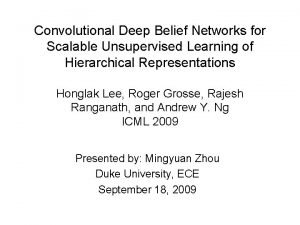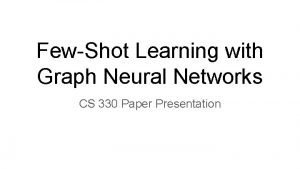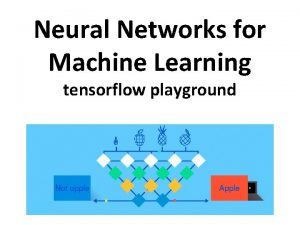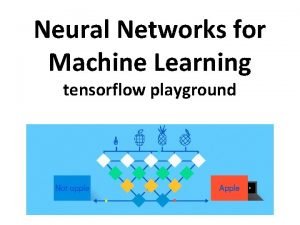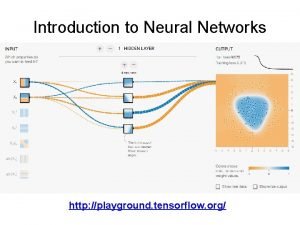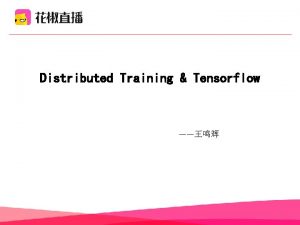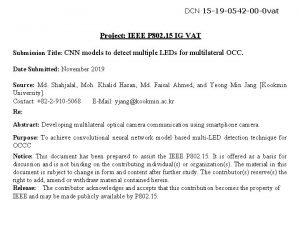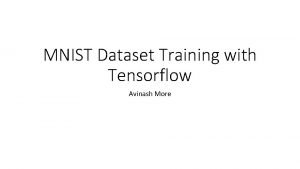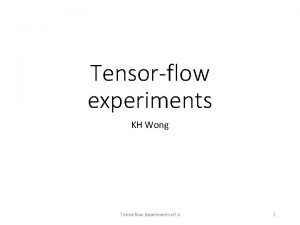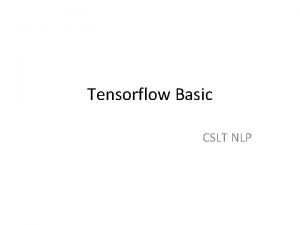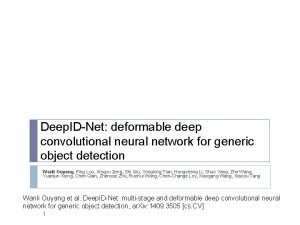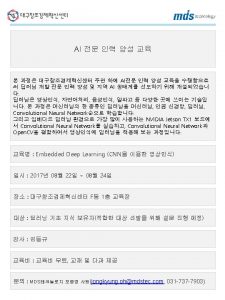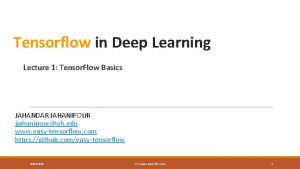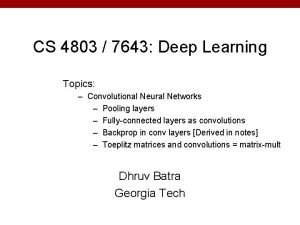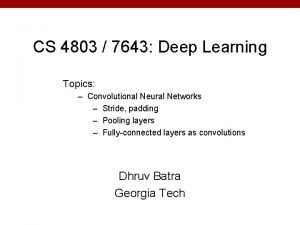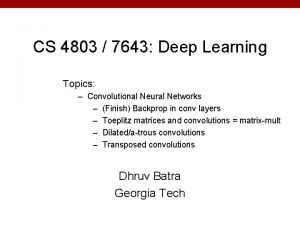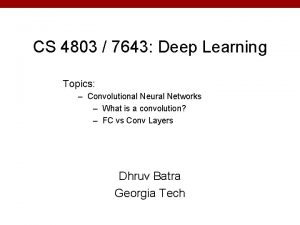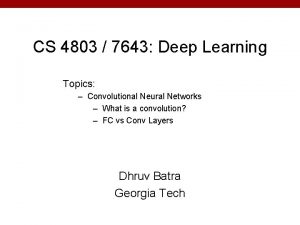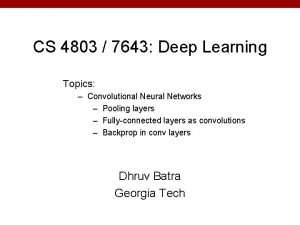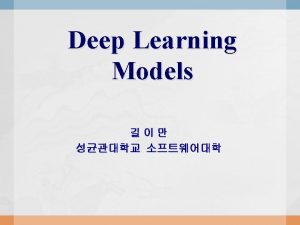Tensorflow in Deep Learning Lecture 4 Convolutional Neural


































- Slides: 34

Tensorflow in Deep Learning Lecture 4: Convolutional Neural Network (CNN) JAHANDAR JAHANIPOUR jjahanipour@uh. edu www. easy-tensorflow. com https: //github. com/easy-tensorflow 01/05/2018 www. easy-tensorflow. com 1

Outline • Feed-Forward Neural Network shortcomings • Convolutional Neural Networks • • • How does a CNN work Convolution layer Pooling layer • Implementing CNN using Tensor. Flow • Save and Restore the Network 01/05/2018 www. easy-tensorflow. com 2

Feed Forward Neural Network (NN) 01/05/2018 www. easy-tensorflow. com 3

Neural Network Problems: 1. Doesn’t use data structure! Translation invariance 01/05/2018 www. easy-tensorflow. com 4

Neural Network Problems: 1. Doesn’t use data structure! Solution: Weight sharing W CNN: W Neural Net that shares it’s parameters across space 01/05/2018 www. easy-tensorflow. com 5

Neural Network Problems: 2. Doesn’t scale well to full images 784 Units 500 Units #parameters = 784 x 500 + 500 = 392 K !!! 01/05/2018 www. easy-tensorflow. com 6

Neural Network Problems: 2. Doesn’t scale well to full images Solution: Weight sharing + 3 D volume of neurons Sharing the same set of weights (and biases) 01/05/2018 www. easy-tensorflow. com 7

Layers Used to Build CNN 01/05/2018 www. easy-tensorflow. com 8

Convolution Layer • 1. slide 2. multiply 3. integrate (i. e. sum) 01/05/2018 www. easy-tensorflow. com 9

Convolution Layer - Spatial dimensions: 32 x 32 - Depth: 3 Feature maps (R+G+B) 01/05/2018 www. easy-tensorflow. com 10

Convolution Layer (Filter = Kernel = Patch) Convolve the filter with the image i. e. “slide over the image spatially, Computing dot products, And sum over all” 01/05/2018 www. easy-tensorflow. com 11

Convolution Layer 01/05/2018 www. easy-tensorflow. com 12

Convolution Layer 01/05/2018 www. easy-tensorflow. com 13

Convolution Layer 01/05/2018 www. easy-tensorflow. com 14

Convolution Layer 01/05/2018 www. easy-tensorflow. com 15

Convolution Layer 01/05/2018 www. easy-tensorflow. com 16

Convolution Layer 01/05/2018 www. easy-tensorflow. com 17

Convolution Layer • A closer look at spatial dimensions: - Input size: i = 7 Filter size: K=3 Stride: s=2 => Output size: o = 3 o=(i-K)/s +1 01/05/2018 www. easy-tensorflow. com 18

Convolution Layer • A closer look at spatial dimensions: - Input size: i = 7 Filter size: K=3 Stride: s=3 o=(i-K)/s +1 = 2. 33 !!! o=(i-K)/s +1 =? 01/05/2018 www. easy-tensorflow. com 19

Convolution Layer • A closer look at spatial dimensions: - Zero-padding: - o=(i+2 p-K)/s +1 Input size: i = 7 Filter size: K=3 Stride: s=3 Zero-pad: p=1 => Output size: o = 3 01/05/2018 www. easy-tensorflow. com 20

Convolution Layer • A closer look at spatial dimensions: • Valid padding: don’t go past the edges • Same padding: go off the edge (with s=1), pad with zeros in such a way that output size = input size o=(i+2 p-K)/s +1 => i=(i+2 p-K)+1 => p=(K-1)/2 01/05/2018 www. easy-tensorflow. com K=3 => zero pad with 1 K=5 => zero pad with 2 K=7 => zero 21

Convolution in Tensor. Flow • • Computes a 2 -D convolution given 4 -D input and filter tensors input: tensor of shape [batch_size, in_height, in_width, in_channels] • filter: tensor of shape [filter_height, filter_width, in_channels, out_channels] 01/05/2018 www. easy-tensorflow. com tf. nn. conv 2 d( input, filter, strides, padding, use_cudnn_on_gpu=True, data_format='NHWC', dilations=[1, 1, 1, 1], name=None ) 22

Helper Function for Convolution Layer def conv_layer(x, filter_size, num_filters, stride, name): with tf. variable_scope(name): num_in_channel = x. get_shape(). as_list()[-1] shape = [filter_size, num_in_channel, num_filters] W = weight_variable(shape=shape) tf. summary. histogram('weight', W) b = bias_variable(shape=[num_filters]) tf. summary. histogram('bias', b) layer = tf. nn. conv 2 d(x, W, strides=[1, stride, 1], padding="SAME") layer += b return tf. nn. relu(layer) 01/05/2018 www. easy-tensorflow. com 23

Pooling Layer To reduce the spatial dimension of feature maps 01/05/2018 www. easy-tensorflow. com reduce the amount of parameters 24

Max Pooling F = Filter Size S = Stride Common Settings: F = 2, S = 2 F = 3, S = 2 01/05/2018 www. easy-tensorflow. com 25

Max Pooling o=(i-F)/s +1 Input size: i = 5 Filter size: F=3 Stride: s=1 => Output size: o = 3 01/05/2018 www. easy-tensorflow. com 26

Average Pooling 01/05/2018 www. easy-tensorflow. com 27

Helper Function for Pooling Layer def max_pool(x, ksize, stride, name): return tf. nn. max_pool(x, ksize=[1, ksize, 1], strides=[1, stride, 1], padding="SAME", name=name) 01/05/2018 www. easy-tensorflow. com 28

Helper Function for Flatten Layer and Fully Connected Layer def fc_layer(x, num_units, name, use_relu=True): def flatten_layer(layer): with tf. variable_scope('Flatten_layer'): layer_shape = layer. get_shape() num_features = layer_shape[1: 4]. num_elements() layer_flat = tf. reshape(layer, [-1, num_features]) return layer_flat 01/05/2018 www. easy-tensorflow. com with tf. variable_scope(name): in_dim = x. get_shape()[1] W = weight_variable(shape=[in_dim, num_units]) tf. summary. histogram('weight', W) b = bias_variable(shape=[num_units]) tf. summary. histogram('bias', b) layer = tf. matmul(x, W) layer += b if use_relu: layer = tf. nn. relu(layer) return layer 29

Remarks on Implementation # hyper-parameters learning_rate = 0. 001# The optimization learning rate epochs = 10 # Total number of training epochs batch_size = 100 # Training batch size # Network Parameters # We know that MNIST images are 28 pixels in each dimension. img_h = img_w = 28 # Images are stored in one-dimensional arrays of this length. img_size_flat = img_h * img_w # Number of classes, one class for each of 10 digits. n_classes = 10 01/05/2018 www. easy-tensorflow. com 30

Remarks on Implementation • Feed-forward network: # Placeholders for inputs (x), outputs(y) with tf. name_scope('input'): x = tf. placeholder(tf. float 32, shape=[None, img_size_flat], name='X') y = tf. placeholder(tf. float 32, shape=[None, n_classes], name='Y') • CNN # Placeholders for inputs (x), outputs(y) with tf. name_scope('input'): x = tf. placeholder(tf. float 32, shape=[None, img_h, img_w, n_channels], name='X') y = tf. placeholder(tf. float 32, shape=[None, n_classes], name='Y') 01/05/2018 www. easy-tensorflow. com 31

Save and Restore Model • Process of training a network is time consuming • Tensor. Flow has an easy solution to save and restore your model: In the graph: saver = tf. train. Saver() 01/05/2018 www. easy-tensorflow. com 32

Save and Restore Model In the session: • Save In the session: (usually after training is done) saver. save(sess, model_path + model_name, global_step) Model is loaded with the Tensor. Flow names ! var_python_name = tf. get_variable("var_tf_name", shape=. . . ) • Restore Variable is saved with this name in the file in the session: (usually before running the test functions) saver. restore(sess, tf. train. latest_checkpoint(model_path)) 01/05/2018 www. easy-tensorflow. com 33

• If you found this workshop interesting: Please consider giving us star on Git. Hub and Follow us for more tutorials https: //github. com/easy-tensorflow • Feel free to leave comments on the tutorials, if you have any questions, suggestions … http: //easy-tensorflow. com/ 01/05/2018 www. easy-tensorflow. com 34
 Deep forest: towards an alternative to deep neural networks
Deep forest: towards an alternative to deep neural networks Tensorflow lecture
Tensorflow lecture Visualizing and understanding convolutional neural networks
Visualizing and understanding convolutional neural networks Convolutional neural networks for visual recognition
Convolutional neural networks for visual recognition Leon gatys
Leon gatys Stride in cnn
Stride in cnn Convolutional neural network alternatives
Convolutional neural network alternatives Sparse convolutional neural networks
Sparse convolutional neural networks Convolutional neural network
Convolutional neural network Introduction to convolutional neural networks
Introduction to convolutional neural networks Convolutional neural networks
Convolutional neural networks Convolutional neural networks
Convolutional neural networks Image super resolution using deep convolutional networks
Image super resolution using deep convolutional networks Deep convolutional networks
Deep convolutional networks Convolutional deep belief networks
Convolutional deep belief networks Cmu machine learning
Cmu machine learning Tony wagner's seven survival skills
Tony wagner's seven survival skills Graph neural network lecture
Graph neural network lecture Nvdla
Nvdla Deep neural networks and mixed integer linear optimization
Deep neural networks and mixed integer linear optimization Convolutional sequence to sequence learning
Convolutional sequence to sequence learning 01:640:244 lecture notes - lecture 15: plat, idah, farad
01:640:244 lecture notes - lecture 15: plat, idah, farad Deep asleep deep asleep it lies
Deep asleep deep asleep it lies 深哉深哉耶穌的愛
深哉深哉耶穌的愛 Cuadro comparativo e-learning y b-learning
Cuadro comparativo e-learning y b-learning Neural networks and learning machines 3rd edition
Neural networks and learning machines 3rd edition Adaptive learning neural network
Adaptive learning neural network Few shot learning with graph neural networks
Few shot learning with graph neural networks My cpu is a neural net processor a learning computer
My cpu is a neural net processor a learning computer Neural networks and learning machines
Neural networks and learning machines Deep learning playground
Deep learning playground Neural network playground
Neural network playground Https://playground.tensorflow.org
Https://playground.tensorflow.org Tensorflow model parallelism
Tensorflow model parallelism Tensorflow dcn
Tensorflow dcn














